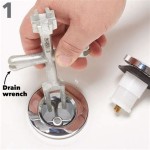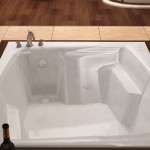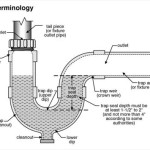Replacement Parts For Bathtub Drain
The bathtub drain, a seemingly simple component, is a vital part of any bathroom plumbing system. Its primary function is to efficiently and effectively remove water from the bathtub after use, preventing overflows and potential water damage. However, over time, bathtub drains can experience wear and tear, leading to leaks, clogs, or complete failure. When this occurs, replacing worn or damaged parts becomes necessary to restore the drain's functionality and prevent further complications. Understanding the various replacement parts available for bathtub drains, along with the associated installation procedures, empowers homeowners and plumbers alike to tackle these repairs effectively.
Bathtub drains are not monolithic structures; they are composed of several interconnected parts, each serving a specific purpose. Identifying the specific component that requires replacement is crucial for a successful repair. This often involves a careful inspection of the drain assembly and a basic understanding of its operating mechanism. Neglecting to address a malfunctioning drain component can lead to more significant and costly repairs down the line. This article outlines common replacement parts for bathtub drains, explains their functions, and provides general guidance on replacement procedures.
Common Bathtub Drain Components and Their Functions
A typical bathtub drain assembly consists of several key components, each contributing to its overall functionality. Understanding the purpose of each part is essential for diagnosing problems and identifying the appropriate replacement.
Drain Stopper: The drain stopper is perhaps the most visible component of the bathtub drain. Its primary function is to seal the drain opening, preventing water from escaping during bathing. Drain stoppers come in various designs, including lift-and-turn, push-and-pull, toe-touch, and pop-up mechanisms. The specific type of stopper installed dictates the mechanism by which the drain is opened and closed. Wear and tear, corrosion, or damage to the stopper's sealing surface can compromise its effectiveness, leading to leaks.
Drain Flange: The drain flange is the metal ring that sits flush with the bathtub surface around the drain opening. It serves as a mounting point for the drain stopper and provides a secure connection to the drain pipe below. The flange is typically made of brass, chrome, or stainless steel and is designed to be durable and resistant to corrosion. Over time, however, the flange can become corroded or damaged, requiring replacement to maintain a watertight seal.
Drain Body: The drain body is the main housing of the drain assembly, located beneath the bathtub. It connects the drain flange to the drain pipe and contains the internal mechanisms for operating the drain stopper. The drain body is typically made of brass or PVC and is designed to withstand the constant flow of water and wastewater. Cracks or leaks in the drain body can lead to significant water damage and necessitate its replacement.
Waste and Overflow (W&O) Tube: The waste and overflow (W&O) tube is a pipe that connects the overflow drain (located near the top of the bathtub) to the drain body. Its purpose is to prevent the bathtub from overflowing by diverting excess water into the drain system. The W&O tube is typically made of brass or PVC and is designed to be flexible to accommodate different bathtub configurations. Leaks or damage to the W&O tube can result in water damage behind the bathtub wall.
Trip Lever and Linkage: In some bathtub drain systems, a trip lever located on the overflow plate controls the drain stopper. The trip lever is connected to a linkage that extends down to the drain body and operates the stopper mechanism. Over time, the trip lever or linkage can become corroded, bent, or broken, preventing the drain stopper from functioning properly. Replacement of these components may be necessary to restore the drain's functionality.
Seals and Gaskets: Various seals and gaskets are used throughout the bathtub drain assembly to create watertight connections between the different components. These seals are typically made of rubber or silicone and are designed to prevent leaks. Over time, the seals can deteriorate, crack, or become brittle, leading to leaks. Replacement of these seals is often a necessary part of bathtub drain repair.
Identifying the Need for Replacement Parts
Recognizing the signs that a bathtub drain requires replacement parts is crucial for preventing further damage and ensuring the efficient operation of the plumbing system. Several indicators can suggest the need for attention.
Slow Drainage: One of the most common signs of a bathtub drain problem is slow drainage. This can be caused by a variety of factors, including clogged pipes, a malfunctioning drain stopper, or a partially blocked drain body. If the bathtub takes an unusually long time to drain after use, it may be necessary to inspect and replace the affected components.
Leaks: Leaks around the bathtub drain are a clear indication that something is amiss. Leaks can occur at the drain flange, the W&O tube connection, or the drain body itself. Identifying the source of the leak is essential for determining which parts need to be replaced. Neglecting leaks can lead to water damage, mold growth, and structural problems.
Corrosion: Corrosion on the drain flange, W&O tube, or other drain components can weaken the metal and lead to leaks or failures. Corrosion is often caused by exposure to water, soap, and other chemicals. If significant corrosion is present, replacing the affected parts is recommended.
Damaged Stopper Mechanism: If the drain stopper is not functioning properly, it may be necessary to replace the stopper itself or the associated linkage. A stopper that is difficult to open or close, or that does not seal properly, can indicate a problem with the stopper mechanism.
Visible Wear and Tear: A visual inspection of the bathtub drain components can often reveal signs of wear and tear, such as cracks, breaks, or deterioration of seals. Any visible damage should be addressed promptly to prevent further problems.
In some cases, a complete bathtub drain replacement may be necessary. This is often the case when the drain body is cracked or severely corroded, or when the entire drain assembly is old and outdated. A complete replacement can provide a more reliable and long-lasting solution than simply replacing individual parts.
Replacing Bathtub Drain Parts: A General Overview
Replacing bathtub drain parts typically involves a series of steps, and the specific procedure will vary depending on the type of drain and the part being replaced. However, some general principles apply to most bathtub drain repairs.
Safety First: Before starting any plumbing repair, it is essential to take necessary safety precautions. This includes turning off the water supply to the bathtub and wearing appropriate protective gear, such as gloves and eye protection. Working in a well-ventilated area is also recommended.
Tools and Materials: Gather the necessary tools and materials before starting the repair. This may include a screwdriver, pliers, adjustable wrench, plumber's putty, Teflon tape, and the replacement parts. Having the right tools on hand can make the job easier and more efficient.
Disassembly: Carefully disassemble the existing drain components, taking note of how they are connected. This will help ensure that the new parts are installed correctly. It may be necessary to use penetrating oil to loosen corroded or stuck parts.
Cleaning: Clean all of the mating surfaces before installing the new parts. This will help ensure a good seal and prevent leaks. Use a wire brush or sandpaper to remove any corrosion or debris.
Installation: Install the new parts in the reverse order of disassembly. Be sure to use plumber's putty or Teflon tape to seal all threaded connections. Tighten all connections securely, but avoid over-tightening, which can damage the parts.
Testing: After completing the repair, test the drain to ensure that it is functioning properly and that there are no leaks. Fill the bathtub with water and check for leaks around the drain flange, W&O tube, and other connections. If any leaks are present, tighten the connections or reapply plumber's putty or Teflon tape.
While these steps provide a general overview, it is always recommended to consult with a qualified plumber or refer to the manufacturer's instructions for specific guidance on replacing bathtub drain parts. Incorrect installation can lead to leaks, further damage, and costly repairs.
The availability of replacement parts for bathtub drains allows for the maintenance and repair of existing plumbing systems without the need for complete drain replacement in many cases. By understanding the various components of a bathtub drain, identifying the signs of wear and tear, and following proper installation procedures, homeowners and plumbers can effectively address drain problems and ensure the long-term functionality of their bathroom plumbing.

Replacement Parts For Brass Bathtub Drains

How To Replace A Bathtub Drain

Bathtub Drains And Drain Parts By Watco

Unique Direct Bathtub Drain With Replacement Parts Breakdown

Great Deals On Watco Bathtub Drains And Replacement Parts

Trip Lever Bathtub Drain Assembly Stopper Kit Fit For 1 2 5 8 Strainer

Unique Direct Bathtub Drain With Replacement Parts Breakdown

Easy To Install Universal Tub Drain Trim Kits Fits Common Tubs

Plumbing Do Tub Drains Of The Same Diameter Ever Have Diffe Thread Per Inch Counts Home Improvement Stack Exchange

Sento Chrome Lift And Turn Bathtub Drain Assembly Stopper Kit Fit Both 1 2 Inch Or 5 8 Strainer Heavy Duty Metal With Matching S Easy Installation Polished Com








